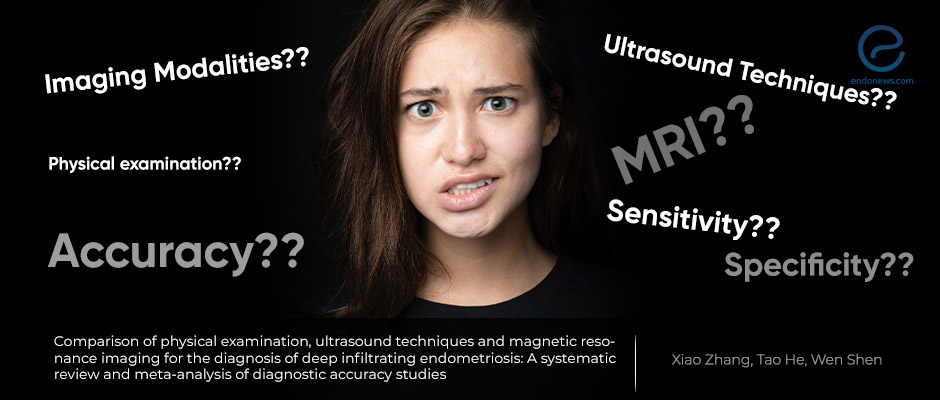Comparison of diagnostic accuracy of imaging modalities for the deep infiltrating endometriosis
Nov 10, 2020
A meta-analysis and review of the imaging methods for diagnostic accuracy.
Key Points
Importance:
- Laparoscopic diagnosis for deeply infiltrated endometriosis is the gold standard. Imaging modalities are highly useful non-invasive screening tools.
Highlights:
- Transvaginal ultrasound (TVUS), transrectal ultrasound (TRUS), and magnetic resonance imaging (MRI) have high diagnostic accuracy for the detection of deeply infiltrating endometriosis.
What's done here:
- A systematic search of the Medline, Scopus, Embase, and Cochrane Library databases was performed.
- Thirty studies with 4565 participants included in the review and meta-analysis.
- The quality of trials was assessed and meta-analysis was performed for pooled sensitivity, specificity, positive and negative likelihood ratios, and the diagnostic accuracy for the clinical and imaging methods for thediagnosis of deeply infiltrating endometriosis.
Key results:
- Pooled sensitivity, specificity, and average diagnostic accuracy of each technique were as following:
- Physical examination: 71%, 69% with an intermediate level of diagnostic value of 0.76.
- Transvaginal Ultrasonography: 76% and 94% with a high diagnostic value of 92%.
- Transrectal Ultrasonography: 91% and 80%, and a high diagnostic value of 93%.
- Magnetic Resonance Imaging: 82% and 87% with a high diagnostic value of 91%.
- Transvaginal Ultrasonography found to be the most specific and transrectal ultrasonography the most sensitive modality for the detection of deeply infiltrating endometriosis.
Limitations:
- There is significant heterogeneity between the studies limiting the interpretation of the pooled outcomes.
- Some of the included studies had a high risk of bias influencing the individual study results.
Lay Summary
The treatment of deeply infiltrated endometriosis (DIE) is usually personalized and the potential success for the available therapeutical options is dependent on early and accurate diagnosis.
Laparoscopy is the gold standard for the diagnosis of DIE. Other non-invasive diagnostic methods including physical examination and imaging techniques such as Transvaginal ultrasound (TVUS), transrectal ultrasound (TRUS), and magnetic resonance imaging (MRI) have never been assessed and compared for the diagnostic accuracy for the diagnosis of DIE.
Zhang et al., from the Department of Ultrasound of Hanchuan Peoples' Hospital, China, collected 30 studies evaluating 4565 participants written in the literature about the value of these methods for the diagnosis of DIE. The comparative results of the evaluation and the meta-analysis were recently published in "Experimental and Therapeutic Medicine".
The risk of bias assessment and meta-analysis was made, and pooled specificity and sensitivity charts prepared. Pooled sensitivity, specificity, and average diagnostic accuracy for physical examination was 71%, 69% with an intermediate level of diagnostic value of 0.76. On the other hand, all the imaging techniques showed higher diagnostic accuracy compared to the physical examination, all being above 0.90.
The most specific tool for the diagnosis of DIE was Transvaginal Ultrasonography (specificity 94%), and the most sensitive modality was transrectal ultrasonography (sensitivity 91%). Only physical exmination had an intermediate value of diagnostic accuracy (sensitivity 71%, specificity 69% and diagnostic accuracy 0.76).
The authors' findings are in line with the international guidelines of diagnostic methods for DIE that suggest TVUS along with physical examination are in the first step of clinical evaluation and can safely be utilized for time-saving screening tool before laparoscopy.
Research Source: https://pubmed.ncbi.nlm.nih.gov/32855690/
Physical examination transvaginal ultrasonography transrectal utrasonography magnetic resonance imaging methodology diagnostic tests deeply infiltrated endometriosis.

